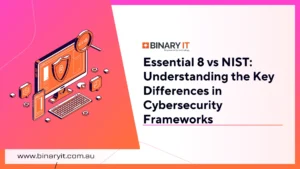Imagine locking your shop every night, but someone still sneaks in, rearranges your shelves, and locks the door behind them. You wouldn’t know anything happened until it’s too late. That’s what poor cybersecurity feels like.
To truly protect your organisation’s data and systems, you need more than just a password; you need a structured approach. Enter the CIA Triad: the foundational model of Confidentiality, Integrity, and Availability that governs how organisations manage data security and protect important security systems.
Whether you’re a small business owner or IT manager, understanding this model is the first step toward a smarter, stronger cybersecurity strategy.
In this blog post, we’ll break down each component of the CIA Triad, show how real-world security breaches target these pillars, and give you practical steps to apply them in your business. By the end, you’ll know exactly why this triad matters and how to build your cybersecurity practices around it.
What is the CIA Triad?
The CIA Triad represents the three aspects of information security that every organisation must address to maintain effective data protection. Think of it as a three-legged stool; if any one component fails, the entire security structure becomes unstable and vulnerable to exploitation.
1. Confidentiality: Keeping data private and accessible only to those who have permission.
2. Integrity: Ensuring data remains accurate, complete, and unaltered unless by authorised means.
3. Availability: Guaranteeing that information and systems are accessible to authorised users whenever they need them.
Here’s what most business owners get wrong: they obsess over one pillar while ignoring the others. I’ve seen companies spend $50,000 on encryption (confidentiality) while running critical systems on a single server with no backup (availability failure waiting to happen).
Concerned your data isn’t as private as it should be? Contact us for a free consultation to assess your access controls, encryption protocols, and insider threat risks before a breach exposes your business.
Breaking Down Each Component of the CIA Triad
Confidentiality
Confidentiality protects the information from unauthorised access, ensuring that sensitive information is accessible only to authorised individuals. It’s about controlling who can see, access, or use your data.
Real-World Example:
In 2019, it came to light that Facebook had stored hundreds of millions of user passwords in plaintext, accessible to thousands of employees. Not encrypted, not hashed, just plain text.
This wasn’t just a technical oversight; it was a breach of confidentiality that exposed users to significant risk. The fallout included public backlash, regulatory probes, and a lasting dent in trust.
What happens when confidentiality is breached?
Unauthorised access to confidential information can lead to identity theft, competitive disadvantage, regulatory fines, and severe damage to your company’s reputation.
Practical Ways to Strengthen Confidentiality:
- Encrypt data at rest and in transit
- Use Multi-Factor Authentication (MFA)
- Implement Role-Based Access Control (RBAC)
- Conduct regular access reviews and updates
- Educate employees on phishing and social engineering
Integrity
Integrity focuses on maintaining the accuracy, completeness, and reliability of data throughout its lifecycle. It ensures that information hasn’t been tampered with, corrupted, or altered by unauthorised parties.
Practical examples of protecting data integrity:
- Using digital signatures to verify document authenticity
- Implementing version control systems for important files
- Regular data backups to prevent corruption
- Access logs that track who modified what information and when
The cost of compromised integrity: When data integrity is compromised, businesses may make decisions based on incorrect information, lose customer trust, or face legal consequences if altered records don’t meet compliance requirements.
Availability
Availability guarantees that authorised users can access systems, applications, and data whenever they need them. It’s about maintaining consistent, reliable access to your digital resources.
The 2016 Dyn DNS attack made major websites, including Twitter, Netflix, and PayPal, inaccessible to millions of users for hours. The economic impact reached hundreds of millions of dollars in lost revenue.
Impact of availability issues: When systems go down, businesses face immediate revenue loss, decreased productivity, frustrated customers, and potential long-term damage to their market position.
How to Ensure Availability:
- Implement redundant systems and failover solutions
- Regularly test disaster recovery plans
- Use uptime monitoring tools
- Ensure off-site backups and cloud availability
Why Is the CIA Triad Important for Businesses?
The CIA Triad provides business leaders with a clear security framework for understanding and managing cybersecurity risks. Rather than viewing security as a complex technical challenge, this model helps decision-makers evaluate cyber threats and allocate resources effectively.
Business Benefits Include:
- Systematic Risk Management – Identifies specific vulnerabilities across all critical security areas
- Regulatory Compliance – Aligns with GDPR, HIPAA, SOX, essential 8, and other regulatory requirements
- Customer Trust – Maintains confidence through comprehensive data protection
- Business Continuity – Ensures operations continue during security incidents
- Cost Management – Prevents expensive breaches and system outages
Financial Impact: Data breaches average $4.45 million per incident, while system outages can cost enterprises over $300,000 per hour in lost productivity and revenue.
Regulatory Alignment:
- GDPR mandates strong confidentiality protections for personal data
- HIPAA – Requires both confidentiality and integrity protections for healthcare information
- SOX – Demands integrity controls for financial reporting systems
By building security programs around the CIA Triad, organisations naturally align with these compliance requirements while protecting their most valuable assets.
Worried that silent data corruption could be costing you more than you know? Reach out today to schedule a no-pressure review of your data validation, audit logging, and change control systems.
How to Assess Your Business Against the CIA Triad?
Understanding the CIA Triad, Confidentiality, Integrity, and Availability, is one thing. Applying it to your business is another. To truly gauge your cybersecurity maturity, you need to ask the right questions that help identify gaps, risks, and next steps. Security controls and security measures are only effective when strategically applied. Below is a structured guide to help you assess each pillar of the CIA triad.
Confidentiality
Confidentiality is all about keeping sensitive information private. Ask yourself:
- Are all sensitive data (customer records, financial info, trade secrets) encrypted both at rest and in transit?
- Do you use multi-factor authentication (MFA) across all critical systems?
- Are access permissions regularly reviewed and updated when employees change roles or leave the company?
- Have you implemented role-based access control (RBAC)?
- Do you monitor who accesses confidential information, and when?
- Are employees trained to spot phishing emails, social engineering attacks, and weak password practices?
If you answered “no” to even one of these, it’s a sign your confidentiality controls may need attention.
Integrity
Data integrity ensures your information is accurate, reliable, and hasn’t been altered without authorisation.
- Do you use audit logs to track changes made to important data and systems?
- Are logs reviewed regularly to detect unusual behavior or unauthorised access?
- Do you have version control or checksums in place to verify that data hasn’t been tampered with?
- Are automated alerts triggered when unexpected changes are made to essential files or systems?
- Do employees have clear procedures to validate incoming data or third-party inputs?
Without strong integrity controls, even minor data manipulation could compromise business decisions or compliance efforts.
Availability
Availability ensures your systems and data are accessible whenever needed, especially during disruptions.
- Do you have automated, regularly tested backups of critical data?
- Is your infrastructure designed with redundancy (e.g., backup servers, power supplies, network routes)?
- Do you have a formal and tested disaster recovery plan (DRP)?
- Is the uptime of essential systems continuously monitored and reported?
- Have you conducted a business continuity drill in the past 6–12 months?
- Can your employees securely access necessary systems remotely if the office is inaccessible (e.g., during natural disasters or pandemics)?
If your answer is “no” or “I’m not sure” to any of these, your ability to stay operational during a crisis could be at risk.
Conclusion
Assessing your business against the CIA Triad isn’t just an IT task; it’s a leadership responsibility. These questions aren’t meant to intimidate, but to illuminate. You don’t have to solve everything overnight, but identifying the weak spots allows you to prioritise improvements based on real risk, not guesswork.
By regularly revisiting these questions, quarterly or annually, and involving key stakeholders (IT, HR, operations, and compliance), you’ll build a robust security posture that’s not only strong but sustainable.
Need help interpreting your results or fixing what’s missing? That’s where cybersecurity consultants can step in and guide your next move. Contact us!





